Team Management Report: Characteristics, Roles, and Development
VerifiedAdded on 2020/01/28
|18
|5557
|481
Report
AI Summary
This report provides a comprehensive analysis of team management principles, focusing on the context of the George Square Hotel in Glasgow, UK. It explores the characteristics of successful business teams, emphasizing the importance of knowledge, defined goals, standards of excellence, risk-taking, and result-oriented approaches. The report delves into the significance of team roles in achieving organizational success, highlighting the need to relate actions to business activities, coordinate with others, foster teamwork, identify issues, and ensure effective communication. Furthermore, it examines the value of theoretical models, such as Tuckman's stages, in building successful teams, emphasizing their role in increasing team strength, enhancing efficiency, improving communication, and achieving positive outcomes. The report also outlines the stages of team development (forming, storming, norming, performing, and adjourning) and provides practical strategies for motivating team members, encouraging communication, resolving conflicts, monitoring performance, and improving team outcomes.
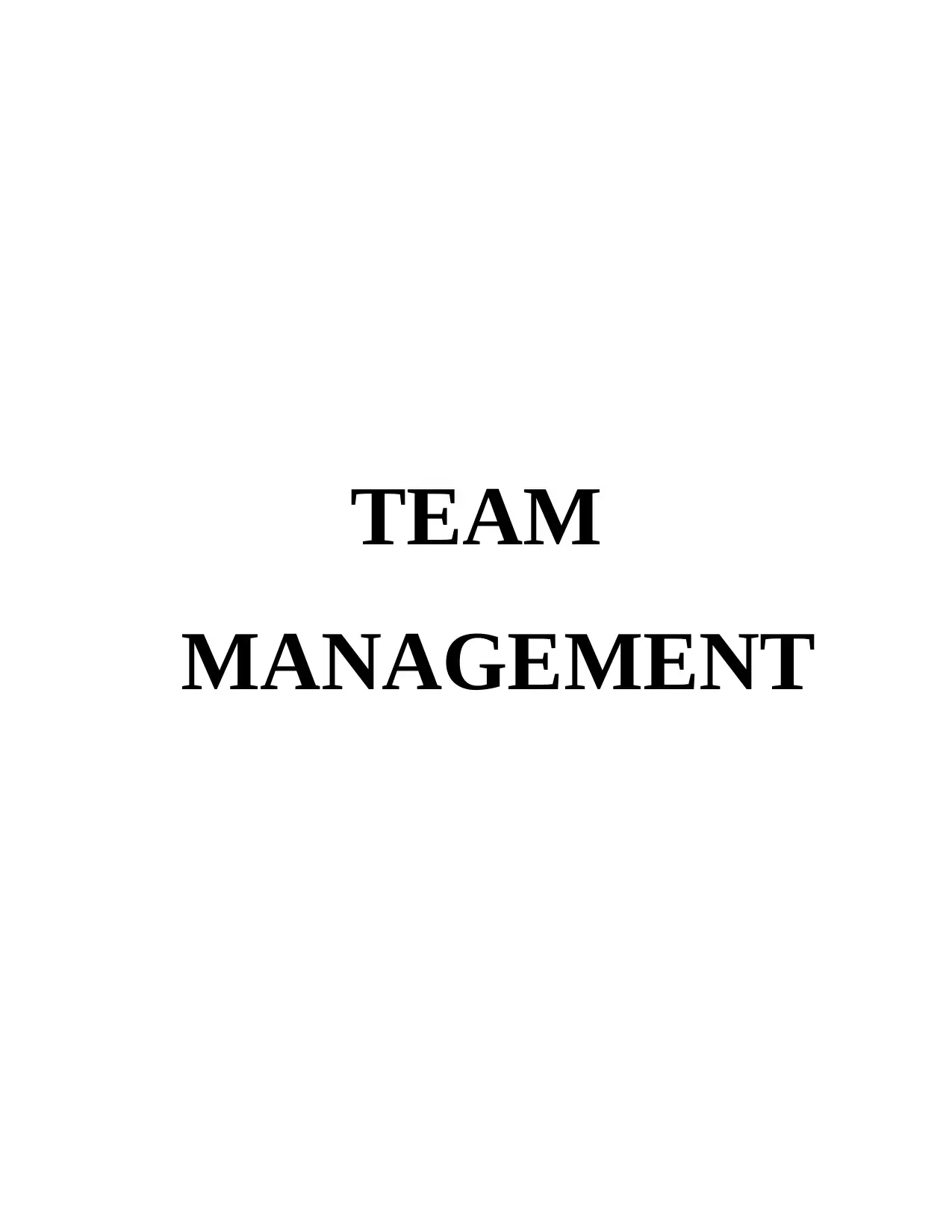
TEAM
MANAGEMENT
MANAGEMENT
Paraphrase This Document
Need a fresh take? Get an instant paraphrase of this document with our AI Paraphraser
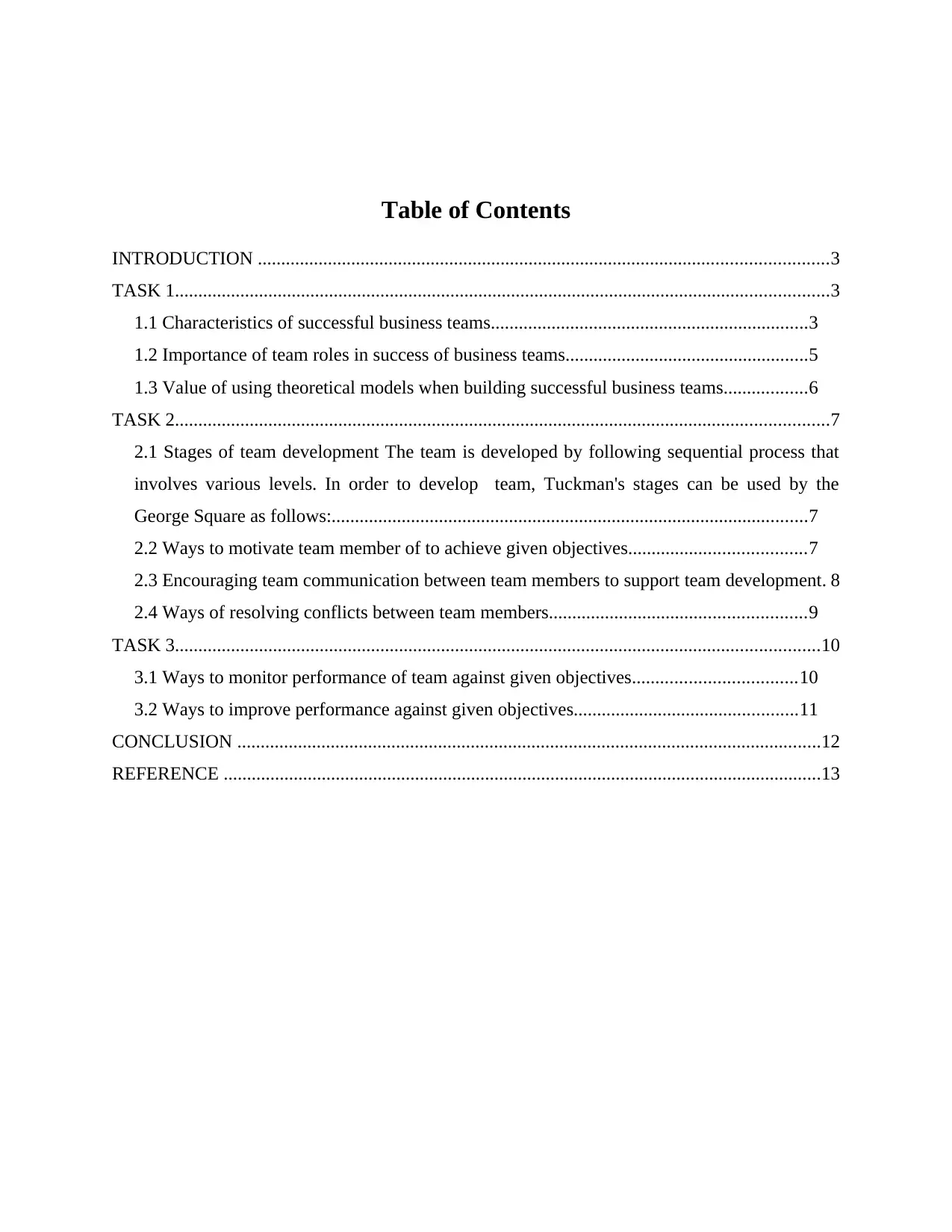
Table of Contents
INTRODUCTION ..........................................................................................................................3
TASK 1............................................................................................................................................3
1.1 Characteristics of successful business teams....................................................................3
1.2 Importance of team roles in success of business teams....................................................5
1.3 Value of using theoretical models when building successful business teams..................6
TASK 2............................................................................................................................................7
2.1 Stages of team development The team is developed by following sequential process that
involves various levels. In order to develop team, Tuckman's stages can be used by the
George Square as follows:......................................................................................................7
2.2 Ways to motivate team member of to achieve given objectives......................................7
2.3 Encouraging team communication between team members to support team development. 8
2.4 Ways of resolving conflicts between team members.......................................................9
TASK 3..........................................................................................................................................10
3.1 Ways to monitor performance of team against given objectives...................................10
3.2 Ways to improve performance against given objectives................................................11
CONCLUSION .............................................................................................................................12
REFERENCE ................................................................................................................................13
INTRODUCTION ..........................................................................................................................3
TASK 1............................................................................................................................................3
1.1 Characteristics of successful business teams....................................................................3
1.2 Importance of team roles in success of business teams....................................................5
1.3 Value of using theoretical models when building successful business teams..................6
TASK 2............................................................................................................................................7
2.1 Stages of team development The team is developed by following sequential process that
involves various levels. In order to develop team, Tuckman's stages can be used by the
George Square as follows:......................................................................................................7
2.2 Ways to motivate team member of to achieve given objectives......................................7
2.3 Encouraging team communication between team members to support team development. 8
2.4 Ways of resolving conflicts between team members.......................................................9
TASK 3..........................................................................................................................................10
3.1 Ways to monitor performance of team against given objectives...................................10
3.2 Ways to improve performance against given objectives................................................11
CONCLUSION .............................................................................................................................12
REFERENCE ................................................................................................................................13
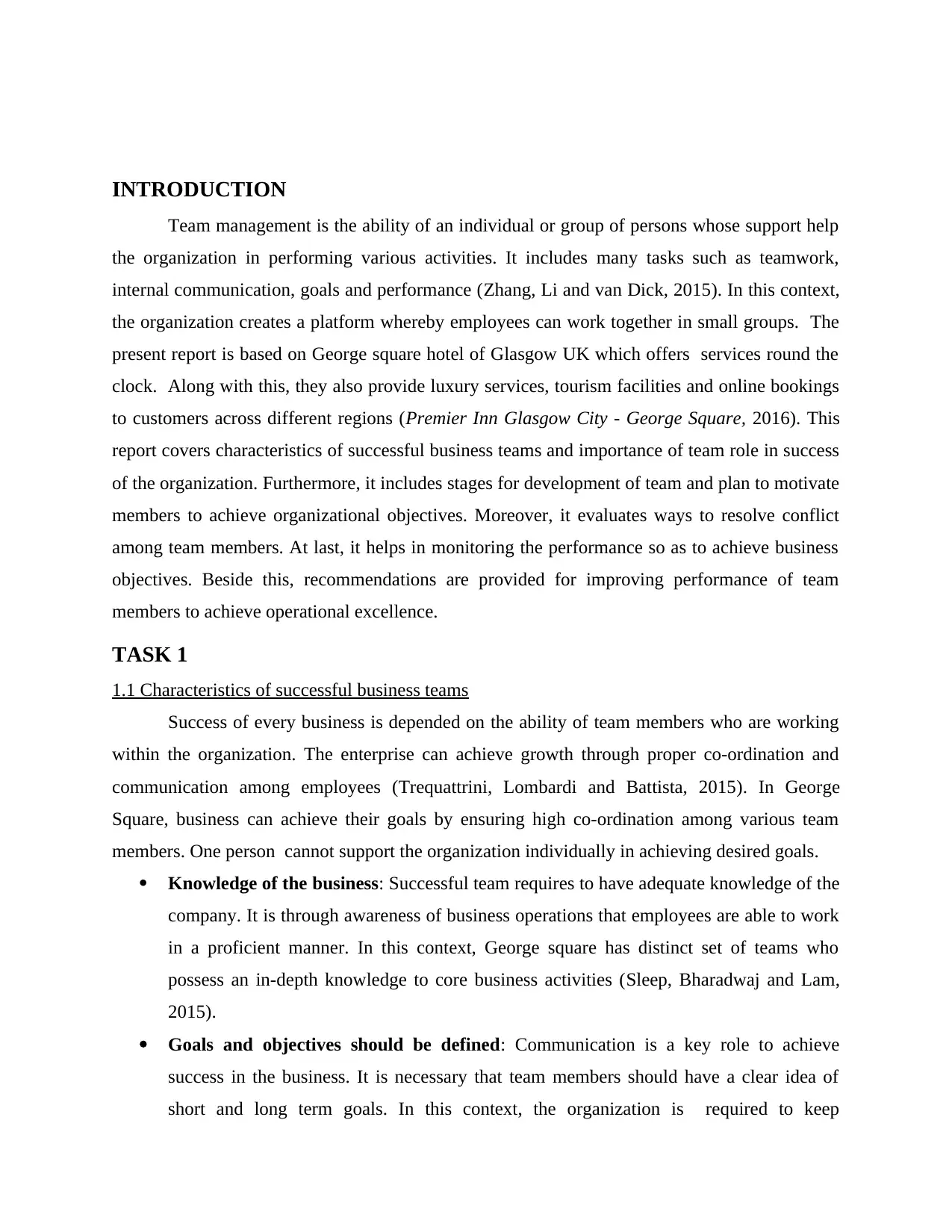
INTRODUCTION
Team management is the ability of an individual or group of persons whose support help
the organization in performing various activities. It includes many tasks such as teamwork,
internal communication, goals and performance (Zhang, Li and van Dick, 2015). In this context,
the organization creates a platform whereby employees can work together in small groups. The
present report is based on George square hotel of Glasgow UK which offers services round the
clock. Along with this, they also provide luxury services, tourism facilities and online bookings
to customers across different regions (Premier Inn Glasgow City - George Square, 2016). This
report covers characteristics of successful business teams and importance of team role in success
of the organization. Furthermore, it includes stages for development of team and plan to motivate
members to achieve organizational objectives. Moreover, it evaluates ways to resolve conflict
among team members. At last, it helps in monitoring the performance so as to achieve business
objectives. Beside this, recommendations are provided for improving performance of team
members to achieve operational excellence.
TASK 1
1.1 Characteristics of successful business teams
Success of every business is depended on the ability of team members who are working
within the organization. The enterprise can achieve growth through proper co-ordination and
communication among employees (Trequattrini, Lombardi and Battista, 2015). In George
Square, business can achieve their goals by ensuring high co-ordination among various team
members. One person cannot support the organization individually in achieving desired goals.
Knowledge of the business: Successful team requires to have adequate knowledge of the
company. It is through awareness of business operations that employees are able to work
in a proficient manner. In this context, George square has distinct set of teams who
possess an in-depth knowledge to core business activities (Sleep, Bharadwaj and Lam,
2015).
Goals and objectives should be defined: Communication is a key role to achieve
success in the business. It is necessary that team members should have a clear idea of
short and long term goals. In this context, the organization is required to keep
Team management is the ability of an individual or group of persons whose support help
the organization in performing various activities. It includes many tasks such as teamwork,
internal communication, goals and performance (Zhang, Li and van Dick, 2015). In this context,
the organization creates a platform whereby employees can work together in small groups. The
present report is based on George square hotel of Glasgow UK which offers services round the
clock. Along with this, they also provide luxury services, tourism facilities and online bookings
to customers across different regions (Premier Inn Glasgow City - George Square, 2016). This
report covers characteristics of successful business teams and importance of team role in success
of the organization. Furthermore, it includes stages for development of team and plan to motivate
members to achieve organizational objectives. Moreover, it evaluates ways to resolve conflict
among team members. At last, it helps in monitoring the performance so as to achieve business
objectives. Beside this, recommendations are provided for improving performance of team
members to achieve operational excellence.
TASK 1
1.1 Characteristics of successful business teams
Success of every business is depended on the ability of team members who are working
within the organization. The enterprise can achieve growth through proper co-ordination and
communication among employees (Trequattrini, Lombardi and Battista, 2015). In George
Square, business can achieve their goals by ensuring high co-ordination among various team
members. One person cannot support the organization individually in achieving desired goals.
Knowledge of the business: Successful team requires to have adequate knowledge of the
company. It is through awareness of business operations that employees are able to work
in a proficient manner. In this context, George square has distinct set of teams who
possess an in-depth knowledge to core business activities (Sleep, Bharadwaj and Lam,
2015).
Goals and objectives should be defined: Communication is a key role to achieve
success in the business. It is necessary that team members should have a clear idea of
short and long term goals. In this context, the organization is required to keep
⊘ This is a preview!⊘
Do you want full access?
Subscribe today to unlock all pages.

Trusted by 1+ million students worldwide
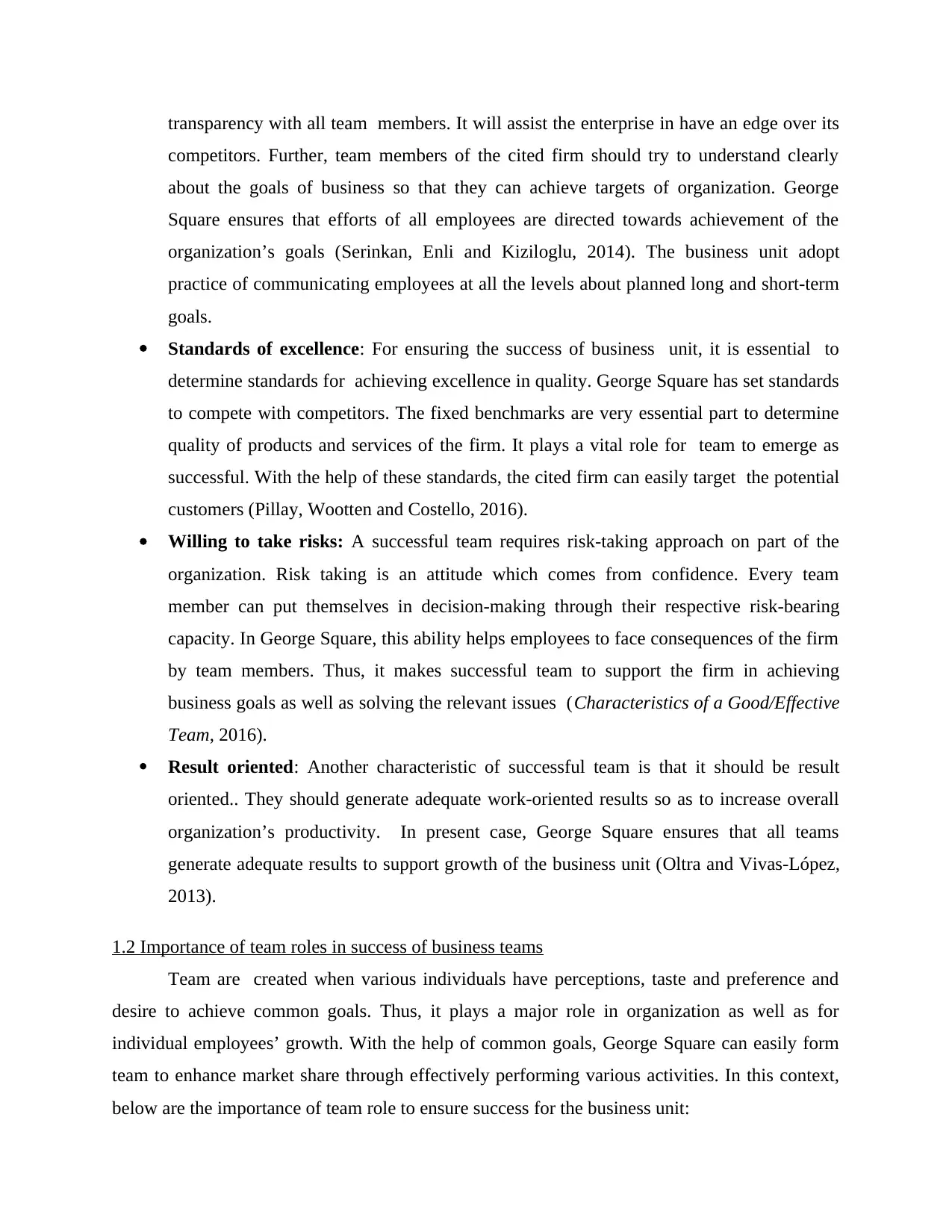
transparency with all team members. It will assist the enterprise in have an edge over its
competitors. Further, team members of the cited firm should try to understand clearly
about the goals of business so that they can achieve targets of organization. George
Square ensures that efforts of all employees are directed towards achievement of the
organization’s goals (Serinkan, Enli and Kiziloglu, 2014). The business unit adopt
practice of communicating employees at all the levels about planned long and short-term
goals.
Standards of excellence: For ensuring the success of business unit, it is essential to
determine standards for achieving excellence in quality. George Square has set standards
to compete with competitors. The fixed benchmarks are very essential part to determine
quality of products and services of the firm. It plays a vital role for team to emerge as
successful. With the help of these standards, the cited firm can easily target the potential
customers (Pillay, Wootten and Costello, 2016).
Willing to take risks: A successful team requires risk-taking approach on part of the
organization. Risk taking is an attitude which comes from confidence. Every team
member can put themselves in decision-making through their respective risk-bearing
capacity. In George Square, this ability helps employees to face consequences of the firm
by team members. Thus, it makes successful team to support the firm in achieving
business goals as well as solving the relevant issues (Characteristics of a Good/Effective
Team, 2016).
Result oriented: Another characteristic of successful team is that it should be result
oriented.. They should generate adequate work-oriented results so as to increase overall
organization’s productivity. In present case, George Square ensures that all teams
generate adequate results to support growth of the business unit (Oltra and Vivas-López,
2013).
1.2 Importance of team roles in success of business teams
Team are created when various individuals have perceptions, taste and preference and
desire to achieve common goals. Thus, it plays a major role in organization as well as for
individual employees’ growth. With the help of common goals, George Square can easily form
team to enhance market share through effectively performing various activities. In this context,
below are the importance of team role to ensure success for the business unit:
competitors. Further, team members of the cited firm should try to understand clearly
about the goals of business so that they can achieve targets of organization. George
Square ensures that efforts of all employees are directed towards achievement of the
organization’s goals (Serinkan, Enli and Kiziloglu, 2014). The business unit adopt
practice of communicating employees at all the levels about planned long and short-term
goals.
Standards of excellence: For ensuring the success of business unit, it is essential to
determine standards for achieving excellence in quality. George Square has set standards
to compete with competitors. The fixed benchmarks are very essential part to determine
quality of products and services of the firm. It plays a vital role for team to emerge as
successful. With the help of these standards, the cited firm can easily target the potential
customers (Pillay, Wootten and Costello, 2016).
Willing to take risks: A successful team requires risk-taking approach on part of the
organization. Risk taking is an attitude which comes from confidence. Every team
member can put themselves in decision-making through their respective risk-bearing
capacity. In George Square, this ability helps employees to face consequences of the firm
by team members. Thus, it makes successful team to support the firm in achieving
business goals as well as solving the relevant issues (Characteristics of a Good/Effective
Team, 2016).
Result oriented: Another characteristic of successful team is that it should be result
oriented.. They should generate adequate work-oriented results so as to increase overall
organization’s productivity. In present case, George Square ensures that all teams
generate adequate results to support growth of the business unit (Oltra and Vivas-López,
2013).
1.2 Importance of team roles in success of business teams
Team are created when various individuals have perceptions, taste and preference and
desire to achieve common goals. Thus, it plays a major role in organization as well as for
individual employees’ growth. With the help of common goals, George Square can easily form
team to enhance market share through effectively performing various activities. In this context,
below are the importance of team role to ensure success for the business unit:
Paraphrase This Document
Need a fresh take? Get an instant paraphrase of this document with our AI Paraphraser
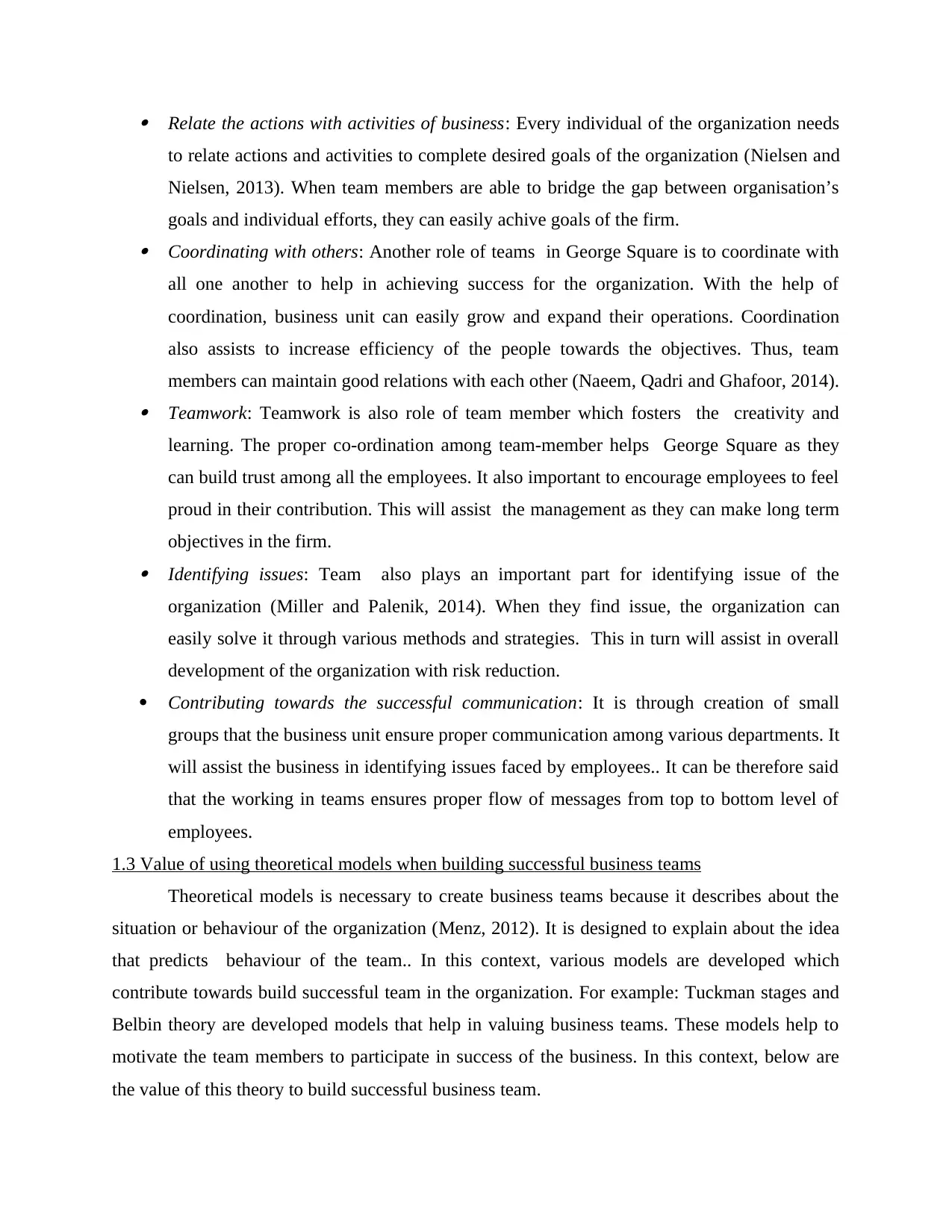
Relate the actions with activities of business: Every individual of the organization needs
to relate actions and activities to complete desired goals of the organization (Nielsen and
Nielsen, 2013). When team members are able to bridge the gap between organisation’s
goals and individual efforts, they can easily achive goals of the firm. Coordinating with others: Another role of teams in George Square is to coordinate with
all one another to help in achieving success for the organization. With the help of
coordination, business unit can easily grow and expand their operations. Coordination
also assists to increase efficiency of the people towards the objectives. Thus, team
members can maintain good relations with each other (Naeem, Qadri and Ghafoor, 2014). Teamwork: Teamwork is also role of team member which fosters the creativity and
learning. The proper co-ordination among team-member helps George Square as they
can build trust among all the employees. It also important to encourage employees to feel
proud in their contribution. This will assist the management as they can make long term
objectives in the firm. Identifying issues: Team also plays an important part for identifying issue of the
organization (Miller and Palenik, 2014). When they find issue, the organization can
easily solve it through various methods and strategies. This in turn will assist in overall
development of the organization with risk reduction.
Contributing towards the successful communication: It is through creation of small
groups that the business unit ensure proper communication among various departments. It
will assist the business in identifying issues faced by employees.. It can be therefore said
that the working in teams ensures proper flow of messages from top to bottom level of
employees.
1.3 Value of using theoretical models when building successful business teams
Theoretical models is necessary to create business teams because it describes about the
situation or behaviour of the organization (Menz, 2012). It is designed to explain about the idea
that predicts behaviour of the team.. In this context, various models are developed which
contribute towards build successful team in the organization. For example: Tuckman stages and
Belbin theory are developed models that help in valuing business teams. These models help to
motivate the team members to participate in success of the business. In this context, below are
the value of this theory to build successful business team.
to relate actions and activities to complete desired goals of the organization (Nielsen and
Nielsen, 2013). When team members are able to bridge the gap between organisation’s
goals and individual efforts, they can easily achive goals of the firm. Coordinating with others: Another role of teams in George Square is to coordinate with
all one another to help in achieving success for the organization. With the help of
coordination, business unit can easily grow and expand their operations. Coordination
also assists to increase efficiency of the people towards the objectives. Thus, team
members can maintain good relations with each other (Naeem, Qadri and Ghafoor, 2014). Teamwork: Teamwork is also role of team member which fosters the creativity and
learning. The proper co-ordination among team-member helps George Square as they
can build trust among all the employees. It also important to encourage employees to feel
proud in their contribution. This will assist the management as they can make long term
objectives in the firm. Identifying issues: Team also plays an important part for identifying issue of the
organization (Miller and Palenik, 2014). When they find issue, the organization can
easily solve it through various methods and strategies. This in turn will assist in overall
development of the organization with risk reduction.
Contributing towards the successful communication: It is through creation of small
groups that the business unit ensure proper communication among various departments. It
will assist the business in identifying issues faced by employees.. It can be therefore said
that the working in teams ensures proper flow of messages from top to bottom level of
employees.
1.3 Value of using theoretical models when building successful business teams
Theoretical models is necessary to create business teams because it describes about the
situation or behaviour of the organization (Menz, 2012). It is designed to explain about the idea
that predicts behaviour of the team.. In this context, various models are developed which
contribute towards build successful team in the organization. For example: Tuckman stages and
Belbin theory are developed models that help in valuing business teams. These models help to
motivate the team members to participate in success of the business. In this context, below are
the value of this theory to build successful business team.
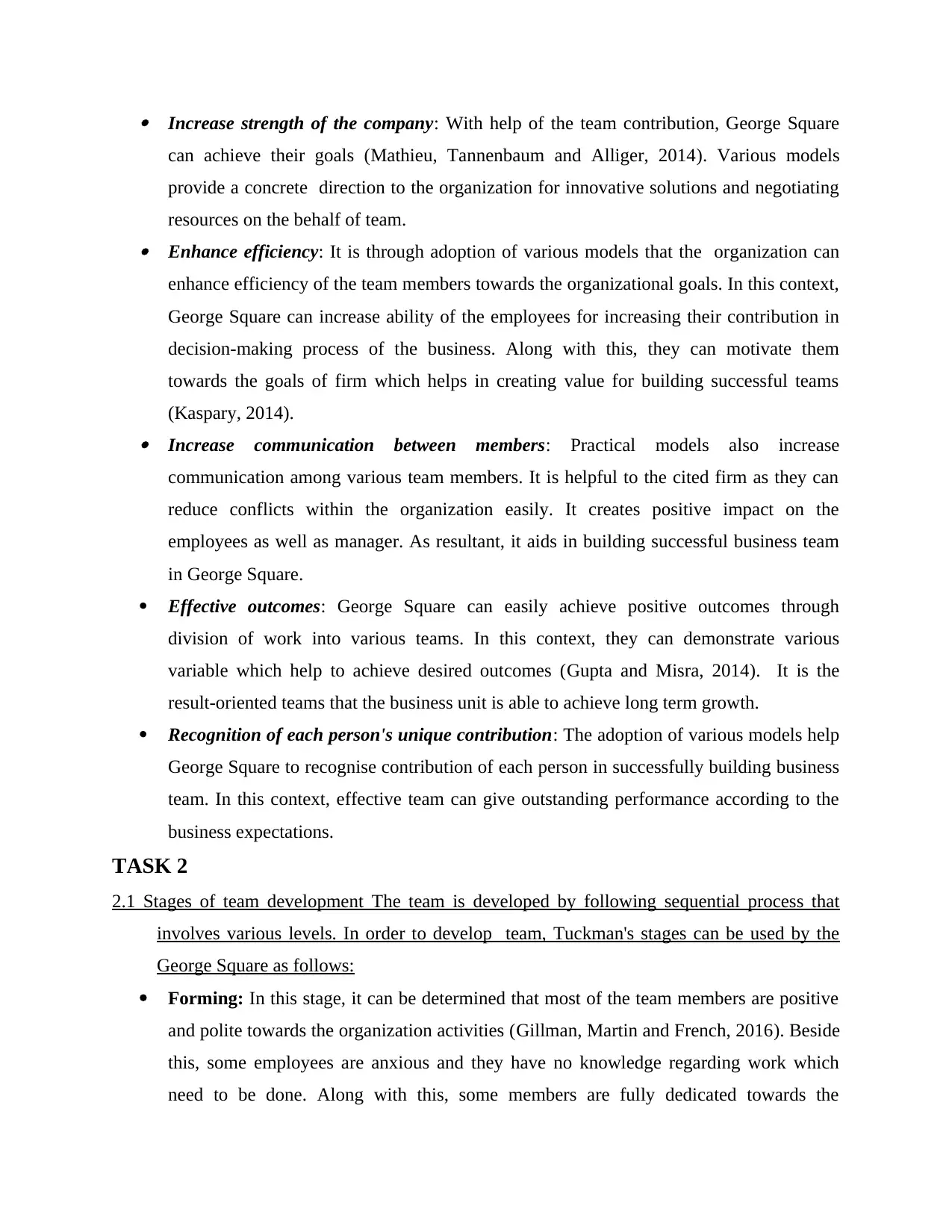
Increase strength of the company: With help of the team contribution, George Square
can achieve their goals (Mathieu, Tannenbaum and Alliger, 2014). Various models
provide a concrete direction to the organization for innovative solutions and negotiating
resources on the behalf of team. Enhance efficiency: It is through adoption of various models that the organization can
enhance efficiency of the team members towards the organizational goals. In this context,
George Square can increase ability of the employees for increasing their contribution in
decision-making process of the business. Along with this, they can motivate them
towards the goals of firm which helps in creating value for building successful teams
(Kaspary, 2014). Increase communication between members: Practical models also increase
communication among various team members. It is helpful to the cited firm as they can
reduce conflicts within the organization easily. It creates positive impact on the
employees as well as manager. As resultant, it aids in building successful business team
in George Square.
Effective outcomes: George Square can easily achieve positive outcomes through
division of work into various teams. In this context, they can demonstrate various
variable which help to achieve desired outcomes (Gupta and Misra, 2014). It is the
result-oriented teams that the business unit is able to achieve long term growth.
Recognition of each person's unique contribution: The adoption of various models help
George Square to recognise contribution of each person in successfully building business
team. In this context, effective team can give outstanding performance according to the
business expectations.
TASK 2
2.1 Stages of team development The team is developed by following sequential process that
involves various levels. In order to develop team, Tuckman's stages can be used by the
George Square as follows:
Forming: In this stage, it can be determined that most of the team members are positive
and polite towards the organization activities (Gillman, Martin and French, 2016). Beside
this, some employees are anxious and they have no knowledge regarding work which
need to be done. Along with this, some members are fully dedicated towards the
can achieve their goals (Mathieu, Tannenbaum and Alliger, 2014). Various models
provide a concrete direction to the organization for innovative solutions and negotiating
resources on the behalf of team. Enhance efficiency: It is through adoption of various models that the organization can
enhance efficiency of the team members towards the organizational goals. In this context,
George Square can increase ability of the employees for increasing their contribution in
decision-making process of the business. Along with this, they can motivate them
towards the goals of firm which helps in creating value for building successful teams
(Kaspary, 2014). Increase communication between members: Practical models also increase
communication among various team members. It is helpful to the cited firm as they can
reduce conflicts within the organization easily. It creates positive impact on the
employees as well as manager. As resultant, it aids in building successful business team
in George Square.
Effective outcomes: George Square can easily achieve positive outcomes through
division of work into various teams. In this context, they can demonstrate various
variable which help to achieve desired outcomes (Gupta and Misra, 2014). It is the
result-oriented teams that the business unit is able to achieve long term growth.
Recognition of each person's unique contribution: The adoption of various models help
George Square to recognise contribution of each person in successfully building business
team. In this context, effective team can give outstanding performance according to the
business expectations.
TASK 2
2.1 Stages of team development The team is developed by following sequential process that
involves various levels. In order to develop team, Tuckman's stages can be used by the
George Square as follows:
Forming: In this stage, it can be determined that most of the team members are positive
and polite towards the organization activities (Gillman, Martin and French, 2016). Beside
this, some employees are anxious and they have no knowledge regarding work which
need to be done. Along with this, some members are fully dedicated towards the
⊘ This is a preview!⊘
Do you want full access?
Subscribe today to unlock all pages.

Trusted by 1+ million students worldwide
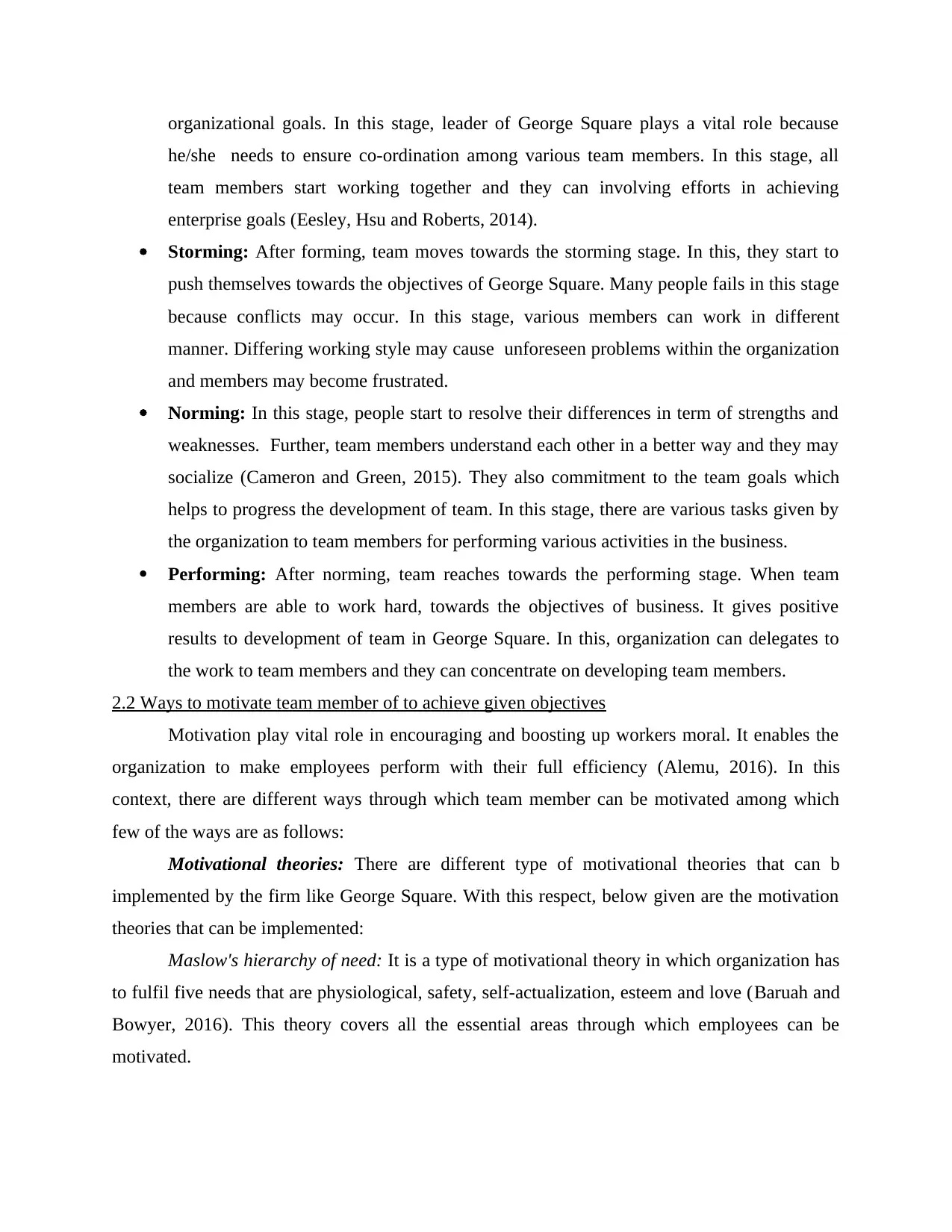
organizational goals. In this stage, leader of George Square plays a vital role because
he/she needs to ensure co-ordination among various team members. In this stage, all
team members start working together and they can involving efforts in achieving
enterprise goals (Eesley, Hsu and Roberts, 2014).
Storming: After forming, team moves towards the storming stage. In this, they start to
push themselves towards the objectives of George Square. Many people fails in this stage
because conflicts may occur. In this stage, various members can work in different
manner. Differing working style may cause unforeseen problems within the organization
and members may become frustrated.
Norming: In this stage, people start to resolve their differences in term of strengths and
weaknesses. Further, team members understand each other in a better way and they may
socialize (Cameron and Green, 2015). They also commitment to the team goals which
helps to progress the development of team. In this stage, there are various tasks given by
the organization to team members for performing various activities in the business.
Performing: After norming, team reaches towards the performing stage. When team
members are able to work hard, towards the objectives of business. It gives positive
results to development of team in George Square. In this, organization can delegates to
the work to team members and they can concentrate on developing team members.
2.2 Ways to motivate team member of to achieve given objectives
Motivation play vital role in encouraging and boosting up workers moral. It enables the
organization to make employees perform with their full efficiency (Alemu, 2016). In this
context, there are different ways through which team member can be motivated among which
few of the ways are as follows:
Motivational theories: There are different type of motivational theories that can b
implemented by the firm like George Square. With this respect, below given are the motivation
theories that can be implemented:
Maslow's hierarchy of need: It is a type of motivational theory in which organization has
to fulfil five needs that are physiological, safety, self-actualization, esteem and love (Baruah and
Bowyer, 2016). This theory covers all the essential areas through which employees can be
motivated.
he/she needs to ensure co-ordination among various team members. In this stage, all
team members start working together and they can involving efforts in achieving
enterprise goals (Eesley, Hsu and Roberts, 2014).
Storming: After forming, team moves towards the storming stage. In this, they start to
push themselves towards the objectives of George Square. Many people fails in this stage
because conflicts may occur. In this stage, various members can work in different
manner. Differing working style may cause unforeseen problems within the organization
and members may become frustrated.
Norming: In this stage, people start to resolve their differences in term of strengths and
weaknesses. Further, team members understand each other in a better way and they may
socialize (Cameron and Green, 2015). They also commitment to the team goals which
helps to progress the development of team. In this stage, there are various tasks given by
the organization to team members for performing various activities in the business.
Performing: After norming, team reaches towards the performing stage. When team
members are able to work hard, towards the objectives of business. It gives positive
results to development of team in George Square. In this, organization can delegates to
the work to team members and they can concentrate on developing team members.
2.2 Ways to motivate team member of to achieve given objectives
Motivation play vital role in encouraging and boosting up workers moral. It enables the
organization to make employees perform with their full efficiency (Alemu, 2016). In this
context, there are different ways through which team member can be motivated among which
few of the ways are as follows:
Motivational theories: There are different type of motivational theories that can b
implemented by the firm like George Square. With this respect, below given are the motivation
theories that can be implemented:
Maslow's hierarchy of need: It is a type of motivational theory in which organization has
to fulfil five needs that are physiological, safety, self-actualization, esteem and love (Baruah and
Bowyer, 2016). This theory covers all the essential areas through which employees can be
motivated.
Paraphrase This Document
Need a fresh take? Get an instant paraphrase of this document with our AI Paraphraser
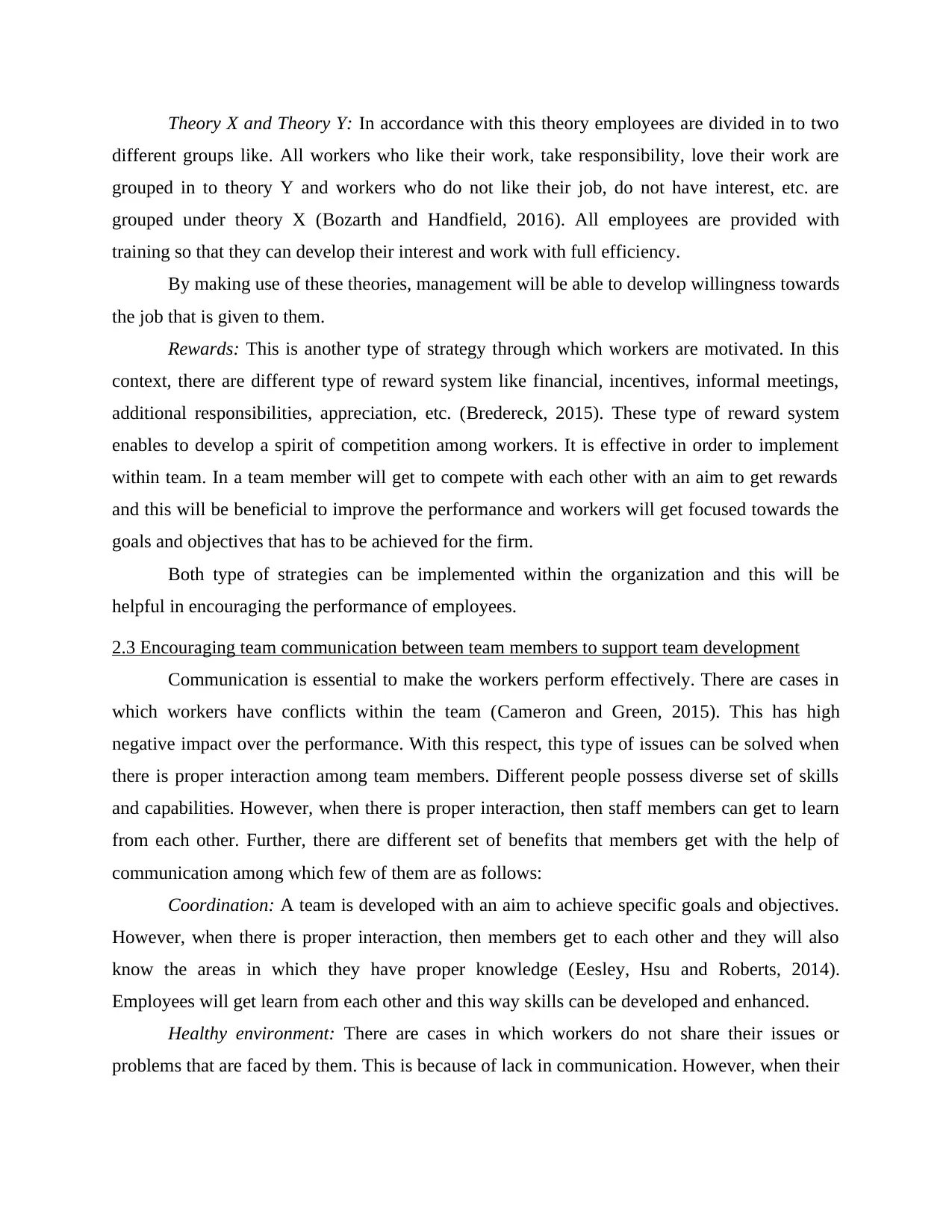
Theory X and Theory Y: In accordance with this theory employees are divided in to two
different groups like. All workers who like their work, take responsibility, love their work are
grouped in to theory Y and workers who do not like their job, do not have interest, etc. are
grouped under theory X (Bozarth and Handfield, 2016). All employees are provided with
training so that they can develop their interest and work with full efficiency.
By making use of these theories, management will be able to develop willingness towards
the job that is given to them.
Rewards: This is another type of strategy through which workers are motivated. In this
context, there are different type of reward system like financial, incentives, informal meetings,
additional responsibilities, appreciation, etc. (Bredereck, 2015). These type of reward system
enables to develop a spirit of competition among workers. It is effective in order to implement
within team. In a team member will get to compete with each other with an aim to get rewards
and this will be beneficial to improve the performance and workers will get focused towards the
goals and objectives that has to be achieved for the firm.
Both type of strategies can be implemented within the organization and this will be
helpful in encouraging the performance of employees.
2.3 Encouraging team communication between team members to support team development
Communication is essential to make the workers perform effectively. There are cases in
which workers have conflicts within the team (Cameron and Green, 2015). This has high
negative impact over the performance. With this respect, this type of issues can be solved when
there is proper interaction among team members. Different people possess diverse set of skills
and capabilities. However, when there is proper interaction, then staff members can get to learn
from each other. Further, there are different set of benefits that members get with the help of
communication among which few of them are as follows:
Coordination: A team is developed with an aim to achieve specific goals and objectives.
However, when there is proper interaction, then members get to each other and they will also
know the areas in which they have proper knowledge (Eesley, Hsu and Roberts, 2014).
Employees will get learn from each other and this way skills can be developed and enhanced.
Healthy environment: There are cases in which workers do not share their issues or
problems that are faced by them. This is because of lack in communication. However, when their
different groups like. All workers who like their work, take responsibility, love their work are
grouped in to theory Y and workers who do not like their job, do not have interest, etc. are
grouped under theory X (Bozarth and Handfield, 2016). All employees are provided with
training so that they can develop their interest and work with full efficiency.
By making use of these theories, management will be able to develop willingness towards
the job that is given to them.
Rewards: This is another type of strategy through which workers are motivated. In this
context, there are different type of reward system like financial, incentives, informal meetings,
additional responsibilities, appreciation, etc. (Bredereck, 2015). These type of reward system
enables to develop a spirit of competition among workers. It is effective in order to implement
within team. In a team member will get to compete with each other with an aim to get rewards
and this will be beneficial to improve the performance and workers will get focused towards the
goals and objectives that has to be achieved for the firm.
Both type of strategies can be implemented within the organization and this will be
helpful in encouraging the performance of employees.
2.3 Encouraging team communication between team members to support team development
Communication is essential to make the workers perform effectively. There are cases in
which workers have conflicts within the team (Cameron and Green, 2015). This has high
negative impact over the performance. With this respect, this type of issues can be solved when
there is proper interaction among team members. Different people possess diverse set of skills
and capabilities. However, when there is proper interaction, then staff members can get to learn
from each other. Further, there are different set of benefits that members get with the help of
communication among which few of them are as follows:
Coordination: A team is developed with an aim to achieve specific goals and objectives.
However, when there is proper interaction, then members get to each other and they will also
know the areas in which they have proper knowledge (Eesley, Hsu and Roberts, 2014).
Employees will get learn from each other and this way skills can be developed and enhanced.
Healthy environment: There are cases in which workers do not share their issues or
problems that are faced by them. This is because of lack in communication. However, when their
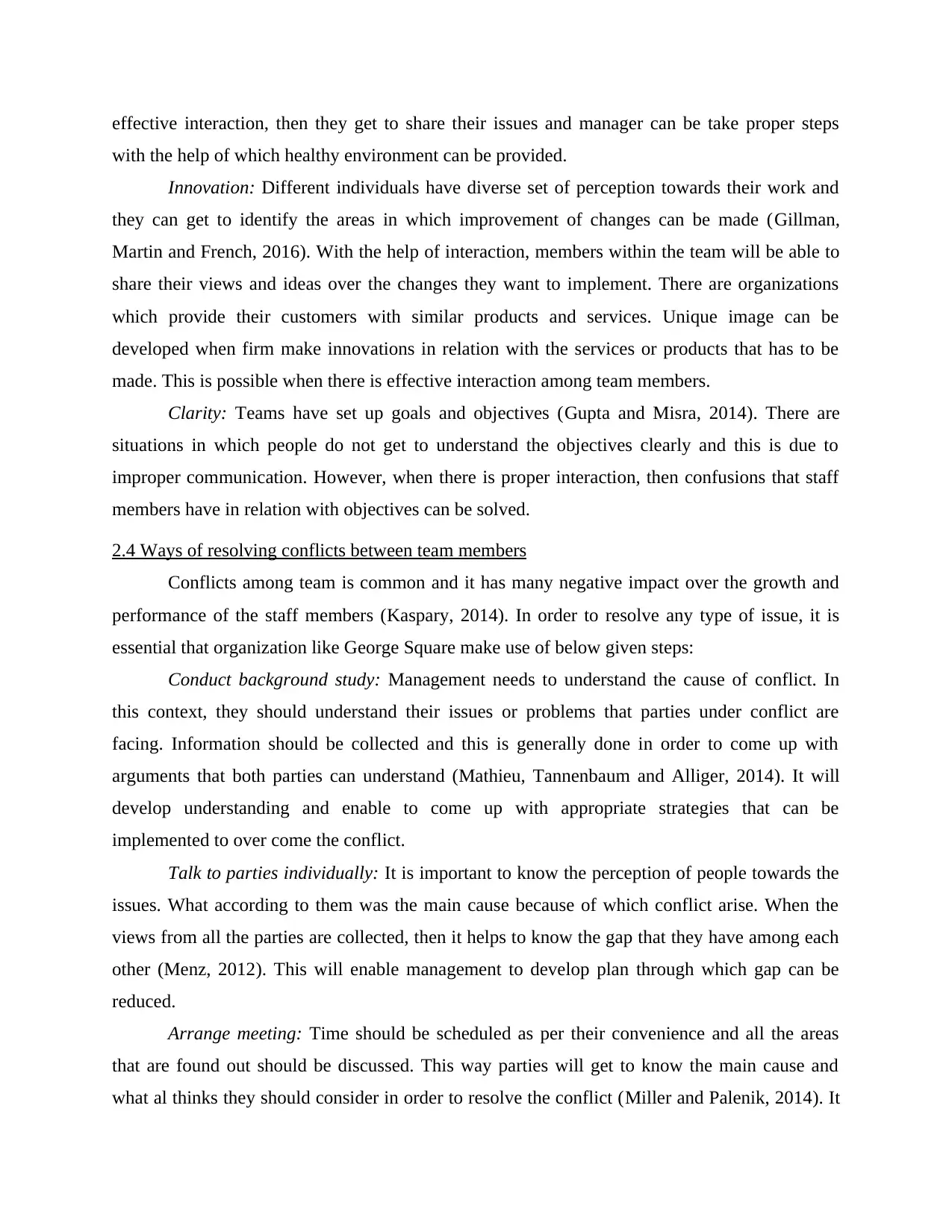
effective interaction, then they get to share their issues and manager can be take proper steps
with the help of which healthy environment can be provided.
Innovation: Different individuals have diverse set of perception towards their work and
they can get to identify the areas in which improvement of changes can be made (Gillman,
Martin and French, 2016). With the help of interaction, members within the team will be able to
share their views and ideas over the changes they want to implement. There are organizations
which provide their customers with similar products and services. Unique image can be
developed when firm make innovations in relation with the services or products that has to be
made. This is possible when there is effective interaction among team members.
Clarity: Teams have set up goals and objectives (Gupta and Misra, 2014). There are
situations in which people do not get to understand the objectives clearly and this is due to
improper communication. However, when there is proper interaction, then confusions that staff
members have in relation with objectives can be solved.
2.4 Ways of resolving conflicts between team members
Conflicts among team is common and it has many negative impact over the growth and
performance of the staff members (Kaspary, 2014). In order to resolve any type of issue, it is
essential that organization like George Square make use of below given steps:
Conduct background study: Management needs to understand the cause of conflict. In
this context, they should understand their issues or problems that parties under conflict are
facing. Information should be collected and this is generally done in order to come up with
arguments that both parties can understand (Mathieu, Tannenbaum and Alliger, 2014). It will
develop understanding and enable to come up with appropriate strategies that can be
implemented to over come the conflict.
Talk to parties individually: It is important to know the perception of people towards the
issues. What according to them was the main cause because of which conflict arise. When the
views from all the parties are collected, then it helps to know the gap that they have among each
other (Menz, 2012). This will enable management to develop plan through which gap can be
reduced.
Arrange meeting: Time should be scheduled as per their convenience and all the areas
that are found out should be discussed. This way parties will get to know the main cause and
what al thinks they should consider in order to resolve the conflict (Miller and Palenik, 2014). It
with the help of which healthy environment can be provided.
Innovation: Different individuals have diverse set of perception towards their work and
they can get to identify the areas in which improvement of changes can be made (Gillman,
Martin and French, 2016). With the help of interaction, members within the team will be able to
share their views and ideas over the changes they want to implement. There are organizations
which provide their customers with similar products and services. Unique image can be
developed when firm make innovations in relation with the services or products that has to be
made. This is possible when there is effective interaction among team members.
Clarity: Teams have set up goals and objectives (Gupta and Misra, 2014). There are
situations in which people do not get to understand the objectives clearly and this is due to
improper communication. However, when there is proper interaction, then confusions that staff
members have in relation with objectives can be solved.
2.4 Ways of resolving conflicts between team members
Conflicts among team is common and it has many negative impact over the growth and
performance of the staff members (Kaspary, 2014). In order to resolve any type of issue, it is
essential that organization like George Square make use of below given steps:
Conduct background study: Management needs to understand the cause of conflict. In
this context, they should understand their issues or problems that parties under conflict are
facing. Information should be collected and this is generally done in order to come up with
arguments that both parties can understand (Mathieu, Tannenbaum and Alliger, 2014). It will
develop understanding and enable to come up with appropriate strategies that can be
implemented to over come the conflict.
Talk to parties individually: It is important to know the perception of people towards the
issues. What according to them was the main cause because of which conflict arise. When the
views from all the parties are collected, then it helps to know the gap that they have among each
other (Menz, 2012). This will enable management to develop plan through which gap can be
reduced.
Arrange meeting: Time should be scheduled as per their convenience and all the areas
that are found out should be discussed. This way parties will get to know the main cause and
what al thinks they should consider in order to resolve the conflict (Miller and Palenik, 2014). It
⊘ This is a preview!⊘
Do you want full access?
Subscribe today to unlock all pages.

Trusted by 1+ million students worldwide
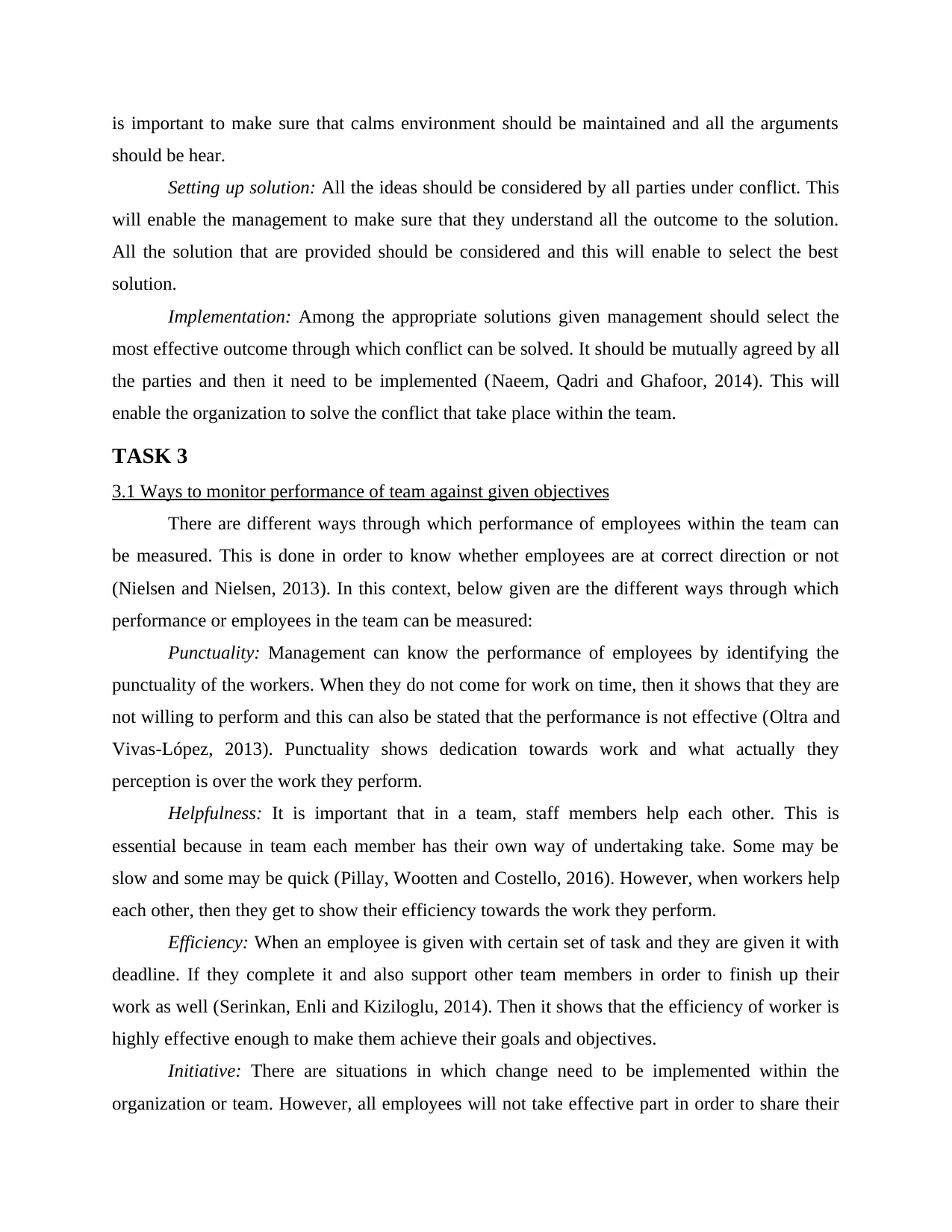
is important to make sure that calms environment should be maintained and all the arguments
should be hear.
Setting up solution: All the ideas should be considered by all parties under conflict. This
will enable the management to make sure that they understand all the outcome to the solution.
All the solution that are provided should be considered and this will enable to select the best
solution.
Implementation: Among the appropriate solutions given management should select the
most effective outcome through which conflict can be solved. It should be mutually agreed by all
the parties and then it need to be implemented (Naeem, Qadri and Ghafoor, 2014). This will
enable the organization to solve the conflict that take place within the team.
TASK 3
3.1 Ways to monitor performance of team against given objectives
There are different ways through which performance of employees within the team can
be measured. This is done in order to know whether employees are at correct direction or not
(Nielsen and Nielsen, 2013). In this context, below given are the different ways through which
performance or employees in the team can be measured:
Punctuality: Management can know the performance of employees by identifying the
punctuality of the workers. When they do not come for work on time, then it shows that they are
not willing to perform and this can also be stated that the performance is not effective (Oltra and
Vivas-López, 2013). Punctuality shows dedication towards work and what actually they
perception is over the work they perform.
Helpfulness: It is important that in a team, staff members help each other. This is
essential because in team each member has their own way of undertaking take. Some may be
slow and some may be quick (Pillay, Wootten and Costello, 2016). However, when workers help
each other, then they get to show their efficiency towards the work they perform.
Efficiency: When an employee is given with certain set of task and they are given it with
deadline. If they complete it and also support other team members in order to finish up their
work as well (Serinkan, Enli and Kiziloglu, 2014). Then it shows that the efficiency of worker is
highly effective enough to make them achieve their goals and objectives.
Initiative: There are situations in which change need to be implemented within the
organization or team. However, all employees will not take effective part in order to share their
should be hear.
Setting up solution: All the ideas should be considered by all parties under conflict. This
will enable the management to make sure that they understand all the outcome to the solution.
All the solution that are provided should be considered and this will enable to select the best
solution.
Implementation: Among the appropriate solutions given management should select the
most effective outcome through which conflict can be solved. It should be mutually agreed by all
the parties and then it need to be implemented (Naeem, Qadri and Ghafoor, 2014). This will
enable the organization to solve the conflict that take place within the team.
TASK 3
3.1 Ways to monitor performance of team against given objectives
There are different ways through which performance of employees within the team can
be measured. This is done in order to know whether employees are at correct direction or not
(Nielsen and Nielsen, 2013). In this context, below given are the different ways through which
performance or employees in the team can be measured:
Punctuality: Management can know the performance of employees by identifying the
punctuality of the workers. When they do not come for work on time, then it shows that they are
not willing to perform and this can also be stated that the performance is not effective (Oltra and
Vivas-López, 2013). Punctuality shows dedication towards work and what actually they
perception is over the work they perform.
Helpfulness: It is important that in a team, staff members help each other. This is
essential because in team each member has their own way of undertaking take. Some may be
slow and some may be quick (Pillay, Wootten and Costello, 2016). However, when workers help
each other, then they get to show their efficiency towards the work they perform.
Efficiency: When an employee is given with certain set of task and they are given it with
deadline. If they complete it and also support other team members in order to finish up their
work as well (Serinkan, Enli and Kiziloglu, 2014). Then it shows that the efficiency of worker is
highly effective enough to make them achieve their goals and objectives.
Initiative: There are situations in which change need to be implemented within the
organization or team. However, all employees will not take effective part in order to share their
Paraphrase This Document
Need a fresh take? Get an instant paraphrase of this document with our AI Paraphraser
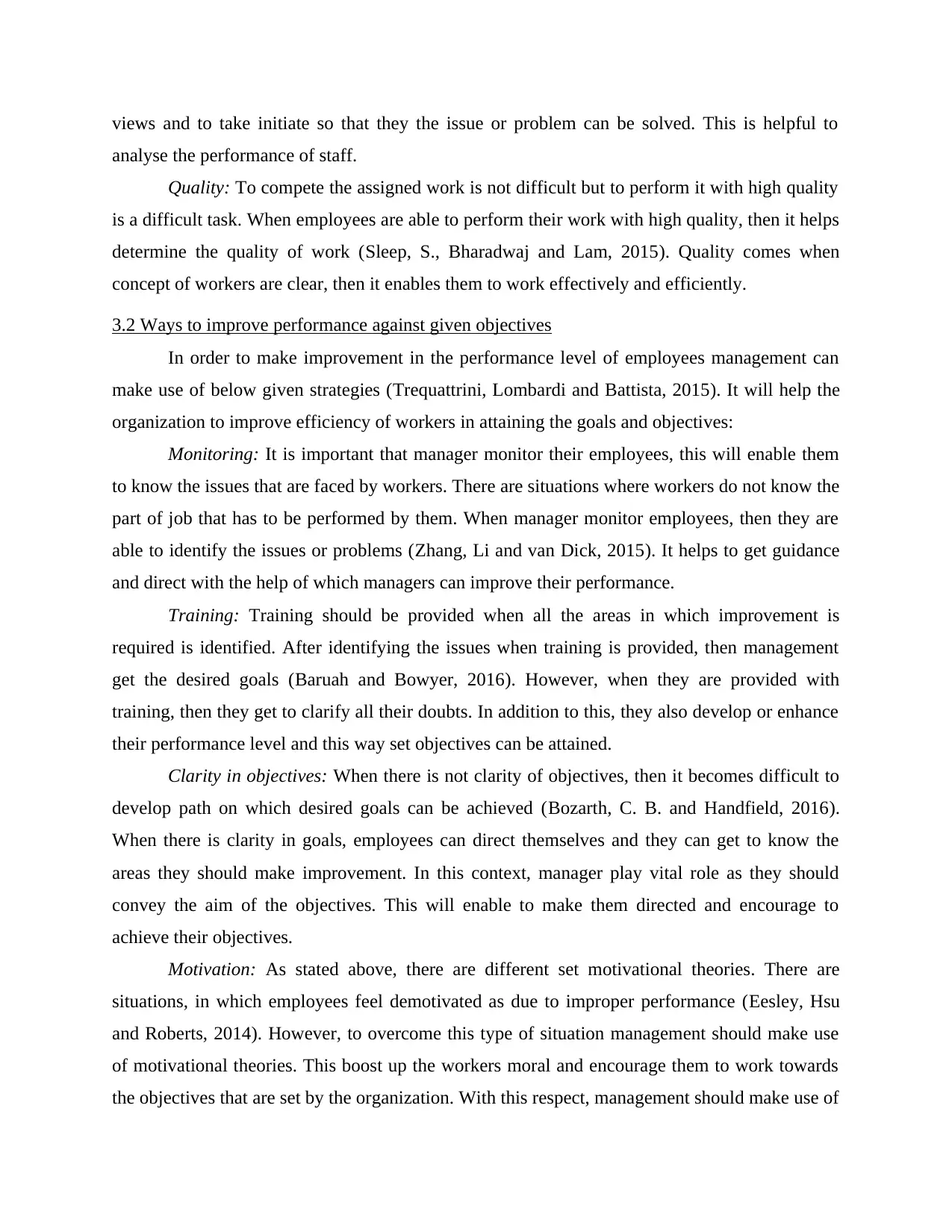
views and to take initiate so that they the issue or problem can be solved. This is helpful to
analyse the performance of staff.
Quality: To compete the assigned work is not difficult but to perform it with high quality
is a difficult task. When employees are able to perform their work with high quality, then it helps
determine the quality of work (Sleep, S., Bharadwaj and Lam, 2015). Quality comes when
concept of workers are clear, then it enables them to work effectively and efficiently.
3.2 Ways to improve performance against given objectives
In order to make improvement in the performance level of employees management can
make use of below given strategies (Trequattrini, Lombardi and Battista, 2015). It will help the
organization to improve efficiency of workers in attaining the goals and objectives:
Monitoring: It is important that manager monitor their employees, this will enable them
to know the issues that are faced by workers. There are situations where workers do not know the
part of job that has to be performed by them. When manager monitor employees, then they are
able to identify the issues or problems (Zhang, Li and van Dick, 2015). It helps to get guidance
and direct with the help of which managers can improve their performance.
Training: Training should be provided when all the areas in which improvement is
required is identified. After identifying the issues when training is provided, then management
get the desired goals (Baruah and Bowyer, 2016). However, when they are provided with
training, then they get to clarify all their doubts. In addition to this, they also develop or enhance
their performance level and this way set objectives can be attained.
Clarity in objectives: When there is not clarity of objectives, then it becomes difficult to
develop path on which desired goals can be achieved (Bozarth, C. B. and Handfield, 2016).
When there is clarity in goals, employees can direct themselves and they can get to know the
areas they should make improvement. In this context, manager play vital role as they should
convey the aim of the objectives. This will enable to make them directed and encourage to
achieve their objectives.
Motivation: As stated above, there are different set motivational theories. There are
situations, in which employees feel demotivated as due to improper performance (Eesley, Hsu
and Roberts, 2014). However, to overcome this type of situation management should make use
of motivational theories. This boost up the workers moral and encourage them to work towards
the objectives that are set by the organization. With this respect, management should make use of
analyse the performance of staff.
Quality: To compete the assigned work is not difficult but to perform it with high quality
is a difficult task. When employees are able to perform their work with high quality, then it helps
determine the quality of work (Sleep, S., Bharadwaj and Lam, 2015). Quality comes when
concept of workers are clear, then it enables them to work effectively and efficiently.
3.2 Ways to improve performance against given objectives
In order to make improvement in the performance level of employees management can
make use of below given strategies (Trequattrini, Lombardi and Battista, 2015). It will help the
organization to improve efficiency of workers in attaining the goals and objectives:
Monitoring: It is important that manager monitor their employees, this will enable them
to know the issues that are faced by workers. There are situations where workers do not know the
part of job that has to be performed by them. When manager monitor employees, then they are
able to identify the issues or problems (Zhang, Li and van Dick, 2015). It helps to get guidance
and direct with the help of which managers can improve their performance.
Training: Training should be provided when all the areas in which improvement is
required is identified. After identifying the issues when training is provided, then management
get the desired goals (Baruah and Bowyer, 2016). However, when they are provided with
training, then they get to clarify all their doubts. In addition to this, they also develop or enhance
their performance level and this way set objectives can be attained.
Clarity in objectives: When there is not clarity of objectives, then it becomes difficult to
develop path on which desired goals can be achieved (Bozarth, C. B. and Handfield, 2016).
When there is clarity in goals, employees can direct themselves and they can get to know the
areas they should make improvement. In this context, manager play vital role as they should
convey the aim of the objectives. This will enable to make them directed and encourage to
achieve their objectives.
Motivation: As stated above, there are different set motivational theories. There are
situations, in which employees feel demotivated as due to improper performance (Eesley, Hsu
and Roberts, 2014). However, to overcome this type of situation management should make use
of motivational theories. This boost up the workers moral and encourage them to work towards
the objectives that are set by the organization. With this respect, management should make use of
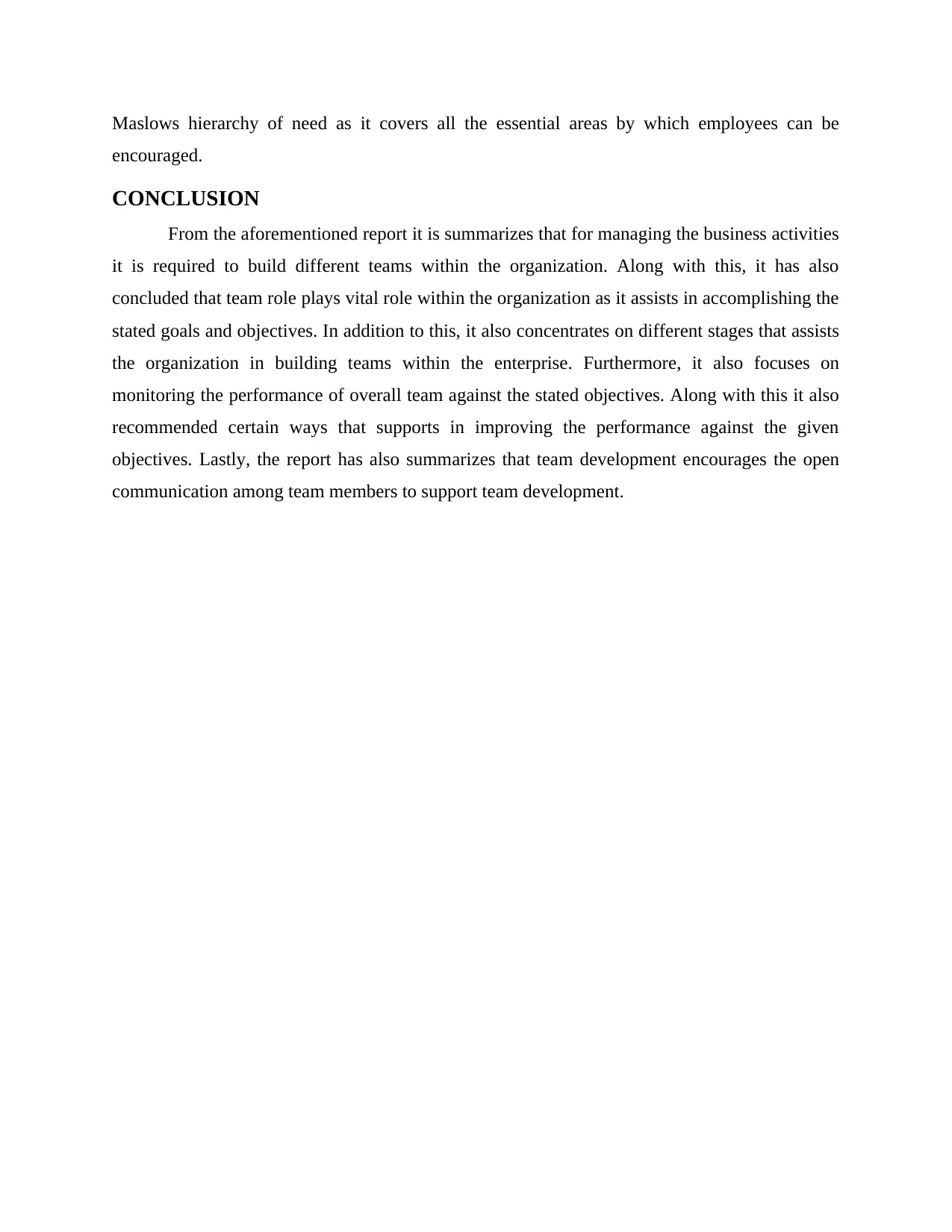
Maslows hierarchy of need as it covers all the essential areas by which employees can be
encouraged.
CONCLUSION
From the aforementioned report it is summarizes that for managing the business activities
it is required to build different teams within the organization. Along with this, it has also
concluded that team role plays vital role within the organization as it assists in accomplishing the
stated goals and objectives. In addition to this, it also concentrates on different stages that assists
the organization in building teams within the enterprise. Furthermore, it also focuses on
monitoring the performance of overall team against the stated objectives. Along with this it also
recommended certain ways that supports in improving the performance against the given
objectives. Lastly, the report has also summarizes that team development encourages the open
communication among team members to support team development.
encouraged.
CONCLUSION
From the aforementioned report it is summarizes that for managing the business activities
it is required to build different teams within the organization. Along with this, it has also
concluded that team role plays vital role within the organization as it assists in accomplishing the
stated goals and objectives. In addition to this, it also concentrates on different stages that assists
the organization in building teams within the enterprise. Furthermore, it also focuses on
monitoring the performance of overall team against the stated objectives. Along with this it also
recommended certain ways that supports in improving the performance against the given
objectives. Lastly, the report has also summarizes that team development encourages the open
communication among team members to support team development.
⊘ This is a preview!⊘
Do you want full access?
Subscribe today to unlock all pages.

Trusted by 1+ million students worldwide
1 out of 18
Related Documents
Your All-in-One AI-Powered Toolkit for Academic Success.
+13062052269
info@desklib.com
Available 24*7 on WhatsApp / Email
![[object Object]](/_next/static/media/star-bottom.7253800d.svg)
Unlock your academic potential
Copyright © 2020–2025 A2Z Services. All Rights Reserved. Developed and managed by ZUCOL.





